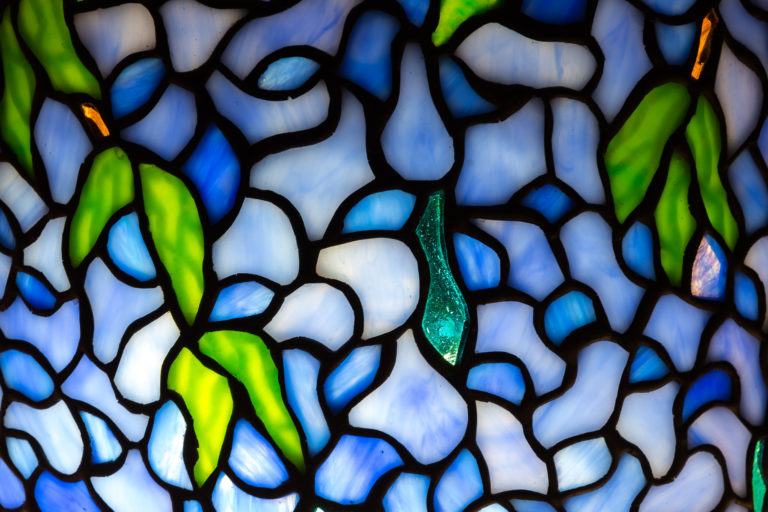
Quick Tips
- Before you start cleaning your stained glass windows, get all your supplies together.
- You'll probably want to lay towels on the windowsill to catch any drips.
- To minimize drips in the first place, wring out the cloth after soaking it in the soap and water mixture.
- Now that you're ready to wash the stained glass window, I recommend starting at the top and working your way downward
- Dip a cotton swab in the soap and water mixture, and use it to clean around the edges and in the corners of each piece of glass.
- After you finish cleaning an individual section of glass, dry it with a second soft cloth or a paper towel.
A year ago, we rented a hundred-year-old duplex with three old stained glass windows. Those windows were a major selling point when it came to choosing an apartment, but for a whole year they made me feel kind of dirty. While everything else in the place got scrubbed and polished on a pretty regular basis, I never touched the stained glass windows. And my guess is that most of the house’s previous occupants also left them alone to get dusty, oxidized, and dull. After all, a stained glass window is a work of art, and you can’t just wash a work of art with regular all-purpose cleaner. Obviously. But what are you supposed to use? As it turns out, nothing if you can help it. To maintain clean stained glass windows, you should just dust them occasionally with a soft dry cloth. But if, like me, you suspect your antique stained glass hasn’t been cleaned in a couple of decades, you might want to work your way through a few steps to get the grunge off them.
In fact, that soft dry cloth is a good place to start. If that seems to be leaving behind some filth, you’ll want to put water on the cloth (distilled water, to avoid streaks or spots). If you’re still seeing a dirty residue on the glass, you can move on to an ammonia-free, vinegar-free, non-abrasive, pH-neutral cleaner. For normal cleaning of residential stained glass, this should do the trick. If you’re working with severely soiled glass, you’ll need something stronger and maybe the help of a professional.
Steps to Cleaning Stained Glass
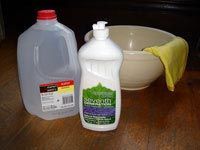 Before you start cleaning your stained glass windows, get all your supplies together. You’ll need a large bowl; at least one gallon of distilled water from the grocery store; a soft cloth, like the microfiber cloth in the picture, which I got in the automotive aisle at a department store; and a gentle cleaner if your windows require it. I used Seventh Generation Natural Dish Liquid because it doesn’t contain any ammonia, vinegar, or abrasives. And according to Seventh Generation’s website, it has a pH between 6.5 and 7.5. Perfect. Once you’ve assembled your supplies, you can mix the distilled water with a small amount of dish soap in the bowl.
Before you start cleaning your stained glass windows, get all your supplies together. You’ll need a large bowl; at least one gallon of distilled water from the grocery store; a soft cloth, like the microfiber cloth in the picture, which I got in the automotive aisle at a department store; and a gentle cleaner if your windows require it. I used Seventh Generation Natural Dish Liquid because it doesn’t contain any ammonia, vinegar, or abrasives. And according to Seventh Generation’s website, it has a pH between 6.5 and 7.5. Perfect. Once you’ve assembled your supplies, you can mix the distilled water with a small amount of dish soap in the bowl.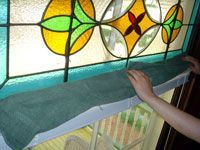 You’ll probably want to lay towels on the windowsill to catch any drips. Otherwise, you risk having your stained glass window cleaning project turn into a wall and floor cleaning project, too.
You’ll probably want to lay towels on the windowsill to catch any drips. Otherwise, you risk having your stained glass window cleaning project turn into a wall and floor cleaning project, too.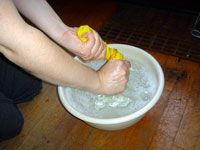 To minimize drips in the first place, wring out the cloth after soaking it in the soap and water mixture.It’s best if the cloth is just damp rather than sopping wet; more water won’t get the glass any cleaner, but it will make more of a mess and increase the risk of streaks and spots when the soapy mixture dries. You should also rinse the cloth often as you clean the window.
To minimize drips in the first place, wring out the cloth after soaking it in the soap and water mixture.It’s best if the cloth is just damp rather than sopping wet; more water won’t get the glass any cleaner, but it will make more of a mess and increase the risk of streaks and spots when the soapy mixture dries. You should also rinse the cloth often as you clean the window.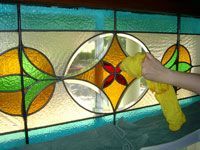 Now that you’re ready to wash the stained glass window, I recommend starting at the top and working your way downward, so you can wipe up any drips from above as you get to the lower parts of the window. In traditional leaded stained glass, individual pieces of glass in different colors and shapes are separated by a thin strip of lead. To clean leaded glass, wash each piece of glass separately before moving on to the next, and be sure to spot test a tiny area of each new color to make sure the stain is fully bonded to the glass and will not come off as you clean. Also, when you encounter stubborn dirt, you can rub the cloth firmly against the glass, but don’t use so much pressure that you risk cracking the window.
Now that you’re ready to wash the stained glass window, I recommend starting at the top and working your way downward, so you can wipe up any drips from above as you get to the lower parts of the window. In traditional leaded stained glass, individual pieces of glass in different colors and shapes are separated by a thin strip of lead. To clean leaded glass, wash each piece of glass separately before moving on to the next, and be sure to spot test a tiny area of each new color to make sure the stain is fully bonded to the glass and will not come off as you clean. Also, when you encounter stubborn dirt, you can rub the cloth firmly against the glass, but don’t use so much pressure that you risk cracking the window.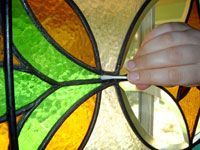 Dip a cotton swab in the soap and water mixture, and use it to clean around the edges and in the corners of each piece of glass. You might be surprised by how much grime your cloth misses in those areas.
Dip a cotton swab in the soap and water mixture, and use it to clean around the edges and in the corners of each piece of glass. You might be surprised by how much grime your cloth misses in those areas.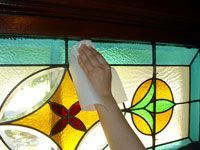 After you finish cleaning an individual section of glass, dry it with a second soft cloth or a paper towel. Then, continue the process with each piece of glass in turn until the whole window is clean. If you can access the glass on the outside of the building, you should repeat this method there for maximum effect. However, many stained glass windows are, like mine, covered by an outside storm window to protect the glass and reduce energy costs. In that case, you’ll have to settle for cleanliness on the inside only. I actually didn’t notice a dramatic difference in the appearance of my windows after I cleaned them, but I was satisfied just knowing how much dirt I had wiped off. If you’d like to see for yourself, move your mouse over the two pictures above.
After you finish cleaning an individual section of glass, dry it with a second soft cloth or a paper towel. Then, continue the process with each piece of glass in turn until the whole window is clean. If you can access the glass on the outside of the building, you should repeat this method there for maximum effect. However, many stained glass windows are, like mine, covered by an outside storm window to protect the glass and reduce energy costs. In that case, you’ll have to settle for cleanliness on the inside only. I actually didn’t notice a dramatic difference in the appearance of my windows after I cleaned them, but I was satisfied just knowing how much dirt I had wiped off. If you’d like to see for yourself, move your mouse over the two pictures above.
Stained Glass and Lead
Lead is really useful stuff. Useful stuff that happens to poison people who inhale or ingest it. Lead poisoning, a phenomenon recognized even by the ancient Greeks and Romans, can cause symptoms in every bodily system. Accelerated tooth decay, digestive problems and infertility can occur alongside the more infamous neurological effects. Children are particularly susceptible to lead toxicity, and exposure to lead puts them at risk for behavioral problems and learning disabilities. Despite our long-standing knowledge of the hazards of lead, people have used the malleable and corrosion-resistant metal in a huge array of products, from water pipes and paint to gasoline and wine. It wasn’t until the 1970s that U.S. lawmakers really focused on limiting its use. But even since then, lead has remained the most common material used for piecing together patterns in stained glass.
This is usually not a big deal, since lead isn’t harmful just sitting there. The only people at high risk from the lead in stained glass are restorers and artists, who can inhale fumes when the lead is heated or dust while they sand or saw strips of lead. But if you have stained glass windows or artwork in your home, there are a few things you should be aware of. First, stained glass lead is supposed to be a dark color, so you shouldn’t worry about trying to polish it. If it will make you feel better to remove residual dirt from the lead, you can do that by the same method you use to clean the glass. Over time, however, lead can develop a powdery white coating due to oxidization. If the lead in your stained glass seems oxidized, put on some gloves and wipe the powder away with a cloth. And then throw the gloves and the cloth away. Finally, if you must restore or move a stained glass window, ventilate your workspace, wear a respirator, and keep children out of the area. Immediately after working with lead you, your clothes, and any surfaces the lead dust may have contacted should be thoroughly washed.
Cleaning Stained Glass Naturally
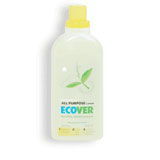 Ecover’s All Purpose Cleanerqualifies as a safe way to clean stained glass. Despite a lemony fragrance, its pH is neutral and it meets all our other criteria for a stained glass cleaner by being non-abrasive and ammonia-free.
Ecover’s All Purpose Cleanerqualifies as a safe way to clean stained glass. Despite a lemony fragrance, its pH is neutral and it meets all our other criteria for a stained glass cleaner by being non-abrasive and ammonia-free.
 Method makes a couple of products that could safely clean stained glass, but I’m going to go ahead and recommend the Daily Granite, since they brag that it’s as gentle on surfaces as water. But much tougher on dirt and stains. You could also use Method’s Window Wash, since unlike many of its green counterparts, this organic window solution contains no acidic vinegar or citrus oils. You can order bottles of Method Granite Cleaner from Amazon.
Method makes a couple of products that could safely clean stained glass, but I’m going to go ahead and recommend the Daily Granite, since they brag that it’s as gentle on surfaces as water. But much tougher on dirt and stains. You could also use Method’s Window Wash, since unlike many of its green counterparts, this organic window solution contains no acidic vinegar or citrus oils. You can order bottles of Method Granite Cleaner from Amazon.
As a bonus, both of these products come in handy spray bottles, but beware the temptation to spray directly on the stained glass. Always spray on a cloth first, and spot test to make sure the cleaner won’t remove any of the color from the glass.